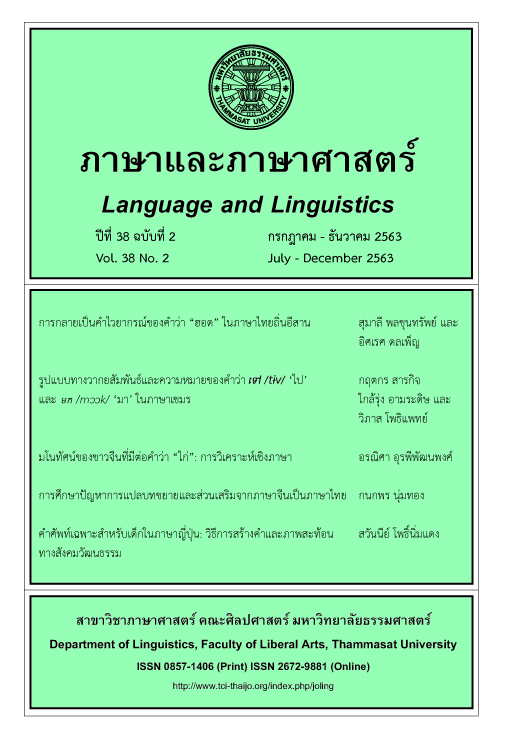Japanese Early Childhood Vocabulary: Word Formation Processes and Socio-cultural Reflections
Main Article Content
Abstract
The study aims to 1) identify the word formation processes in Japanese early childhood vocabulary, 2) investigate the tendency of certain word formation processes to co-occur with particular semantic domains, and 3) analyse the way socio-cultural factors are reflected in Japanese early childhood vocabulary. Data were elicited from Tomosada’s (1997) Zenkoku youjigo jiten [Dictionary of Early Childhood Vocabulary around the Country]. A total of 281 vocabulary items were categorised into 22 semantic domains. Word formation processes, the tendency of occurrence of word formation processes in each semantic domain, and socio-cultural attributes were also analysed. The findings showed seven word formation processes in Japanese early childhood vocabulary. They are ranked from highest to lowest as follows: reduplication, onomatopoeia, sound change, morphemic adaptation (affixation, substitution and omission), conversion, compounding, and borrowing. The study also revealed a co-occurrence tendency between word formation processes and semantic domains. The analysis of socio-cultural reflections indicates that Japanese use of early childhood vocabulary enhances children’s comprehension and facilitates communication. In addition, it was found that the values being fostered in Japanese children include a sense of respect and politeness to surrounding non-human entities, personification of non-human entities, perception of young children’s small objects as being cute, and close and harmonious relationships between children and their family members. Other aspects of Japanese culture; for example, food, clothing, toys, are reflected in early childhood vocabulary as well.
Article Details
บทความทุกบทความเป็นลิขสิทธิ์ของภาษาและภาษาศาสตร์
References
อมรา ประสิทธิ์รัฐสินธุ์. (2556). ภาษาศาสตร์สังคม (พิมพ์ครั้งที่ 5). กรุงเทพฯ: จุฬาลงกรณ์ มหาวิทยาลัย.
Bauer, L. (1983). English word–formation. Cambridge, England: Cambridge University Press.
Bradley, H. (1904). The making of English. London, England: Macmillan.
Ferguson, C. A. (1977). Baby talk as a simplified register. In C. Snow & C.A. Ferguson (Eds.), Talking to children (pp. 209–235). Cambridge, England: Cambridge University Press.
Francis, W. N. (1985). Word-making: Some sources of new words. In V. P. Clark, P. A. Eschholz, & A. E. Rosa (Eds.), Language: Readings in language and culture (4th ed.) (pp. 368–379). New York, NY: St. Martin Press.
Garton, A. F. (1992). Social interaction and the development of language and cognition. Hove, England: Lawrence Erlbaum.
Haspelmath, M. (2002). Understanding morphology. London, England: Arnold.
Kobayashi, T. (2008). 0-3 sai hajimete no kotoba-kotoba no gimon are kore-. Tokyo, Japan: Shougakukan.
Murase, T., Ogura, T., & Yamashita, Y. (2007). Youikusha ni okeru ikujigo shiyou keikou no kouzou to ikujigo shiyou o kitei suru youin. Shakai bunka ronshuu (Shimane daigaku houbungakubu kiyou shakai bunka gakkahen), 4, 17-30. 127
Ogura, T., & Watamaki, T. (2004). Nihongo makkaasaa nyuuyouji gengo hattatsu shitsumonshi ‘Go to miburi’ tebiki. Kyoto, Japan: Kyoto kokusai shakai fukushi sentaa.
Ogura, T., Yoshimoto, Y., & Tsubota, M. (1997). Hahaoya no ikujigo to kodomo no gengo hattatsu, ninchi hattasu. Koube daigaku hattatsu kagakubu kenkyuu kiyou, 5(1), 1-14.
Ono, M. (2011). Giongo ・ gitaigo 4500 nihongo onomatope jiten. Tokyo, Japan: Shougakukan.
Pine, J. M. (1994). The language of primary caregivers. In C. Gallaway & B. Richards (Eds.), Input and interaction in language acquisition (pp. 15-37). Cambridge, England: Cambridge University Press.
Stanford University. (2015). CDI: Adaptations in other languages. Retrieved June 22, 2020, from https://mb-cdi.stanford.edu/adaptations.html
Tanigo, S. (2014). Nihongo no nyuuyoujiki ni miru bikago. Nihongo to kankokugo ni okeru keigo no imi ・ kinou ni kansuru kenkyuu (Koubeshi gaikokugo daigaku gakujutsu jouhou ripojitori), 47, 147-157.
Thanavisuth, C. (1997). Phonetic and pragmatic characteristics of infant directed speech in Thai: A longitudinal study (Doctoral thesis, Chulalongkorn University). Retrieved from http://cuir.car.chula.ac.th/
Tomosada, K. (1997). Zenkoku youjigo jiten. Tokyo, Japan: Tokyodou shuppan.
Tomosada, K. (2005). Ikujigoi no hiraku sekai. Osaka, Japan: Izumi shoin.
Yule, G. (2010). The study of language (4th ed.). Cambridge, England: Cambridge University Press.


